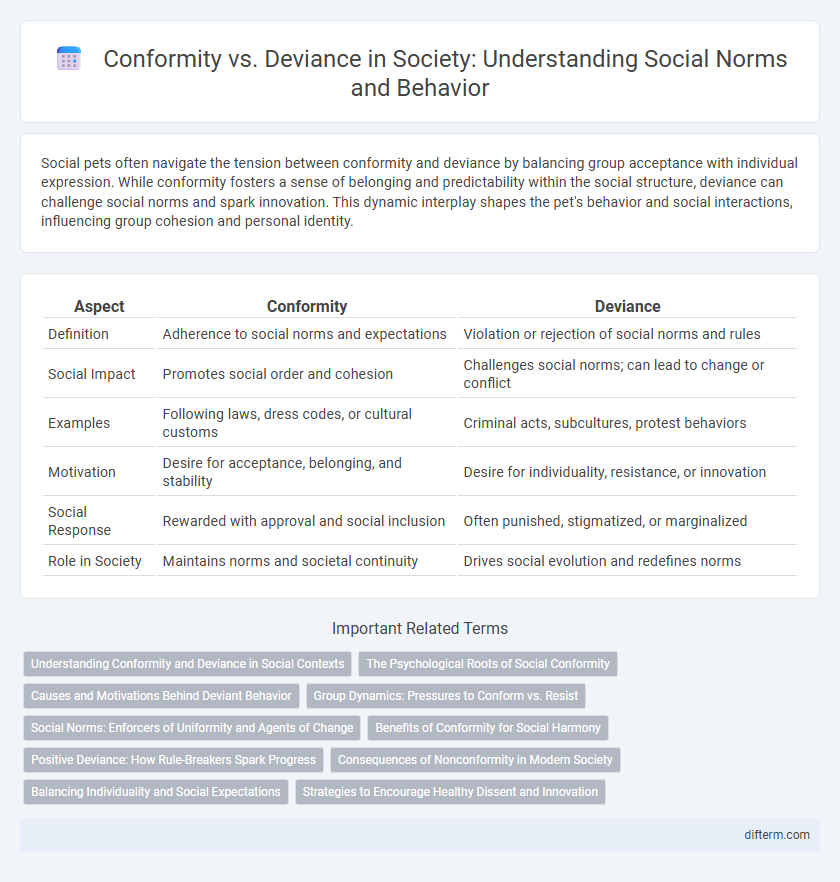Social pets often navigate the tension between conformity and deviance by balancing group acceptance with individual expression. While conformity fosters a sense of belonging and predictability within the social structure, deviance can challenge social norms and spark innovation. This dynamic interplay shapes the pet's behavior and social interactions, influencing group cohesion and personal identity.
Table of Comparison
| Aspect | Conformity | Deviance |
|---|---|---|
| Definition | Adherence to social norms and expectations | Violation or rejection of social norms and rules |
| Social Impact | Promotes social order and cohesion | Challenges social norms; can lead to change or conflict |
| Examples | Following laws, dress codes, or cultural customs | Criminal acts, subcultures, protest behaviors |
| Motivation | Desire for acceptance, belonging, and stability | Desire for individuality, resistance, or innovation |
| Social Response | Rewarded with approval and social inclusion | Often punished, stigmatized, or marginalized |
| Role in Society | Maintains norms and societal continuity | Drives social evolution and redefines norms |
Understanding Conformity and Deviance in Social Contexts
Conformity involves aligning behaviors and beliefs with group norms to gain social acceptance and avoid sanctions, while deviance entails actions that violate those norms, often prompting social control mechanisms. Social psychologists analyze how factors like peer pressure, cultural expectations, and authority influence individuals' decisions to conform or deviate. Understanding these dynamics reveals the complex interplay between individual agency and societal structure in shaping social order.
The Psychological Roots of Social Conformity
Social conformity is deeply rooted in the human need for acceptance and belonging, influenced by the brain's reward system that reinforces group cohesion. Psychological mechanisms such as normative social influence prompt individuals to align their behaviors with group expectations to avoid social rejection. Cognitive processes, including internalization and social identity theory, further explain how conformity shapes personal attitudes and self-concept within social frameworks.
Causes and Motivations Behind Deviant Behavior
Deviant behavior often stems from social, psychological, and economic factors that challenge established norms. Motivations such as the desire for personal gain, rejection of societal values, or response to perceived injustice drive individuals to deviate from conformity. Understanding these causes requires analyzing the influence of peer pressure, identity formation, and structural inequalities on behavior patterns.
Group Dynamics: Pressures to Conform vs. Resist
Group dynamics significantly influence conformity as individuals often face pressures to align with collective norms to maintain social harmony and acceptance. Resistance to conformity arises when personal values or beliefs conflict with group expectations, leading to deviant behavior that challenges social cohesion. Psychological factors such as peer influence, fear of rejection, and desire for approval play critical roles in the tension between conforming and resisting group pressures.
Social Norms: Enforcers of Uniformity and Agents of Change
Social norms act as powerful enforcers of conformity by dictating acceptable behaviors and maintaining societal order through implicit and explicit sanctions. Deviance challenges these norms, positioning individuals as agents of change who inspire social evolution by questioning established practices. Understanding the dynamic tension between conformity and deviance highlights how social norms both preserve unity and facilitate progress within communities.
Benefits of Conformity for Social Harmony
Conformity fosters social harmony by promoting shared norms and reducing conflicts, which enhances group cohesion and cooperation. It encourages predictability in behavior, making social interactions smoother and more stable. Adhering to societal expectations also supports collective goals and strengthens community bonds.
Positive Deviance: How Rule-Breakers Spark Progress
Positive deviance occurs when individuals or groups break social norms in ways that benefit society, inspiring innovation and progress. These rule-breakers challenge conventional thinking, creating solutions to persistent problems in health, education, and community development. Embracing positive deviance fosters adaptive change by highlighting uncommon but successful behaviors within existing social systems.
Consequences of Nonconformity in Modern Society
Nonconformity in modern society often results in social exclusion, reduced professional opportunities, and stigmatization, impacting individuals' mental health and social integration. Deviant behavior may provoke legal repercussions or reinforce negative stereotypes, perpetuating cycles of marginalization. Despite these consequences, nonconformity can drive social change by challenging dominant norms and promoting diversity.
Balancing Individuality and Social Expectations
Balancing individuality and social expectations requires understanding the dynamic between conformity and deviance, where conformity promotes social cohesion through shared norms, while deviance challenges boundaries and fosters social change. Social psychology highlights that moderate deviance encourages innovation without threatening group stability, ensuring that individual expression coexists with collective harmony. Effective social environments cultivate tolerance for diverse behaviors, enabling individuals to assert uniqueness while maintaining essential social bonds.
Strategies to Encourage Healthy Dissent and Innovation
Promoting healthy dissent requires creating an inclusive environment where diverse perspectives are valued and open dialogue is encouraged, reducing the risks of groupthink and conformity. Implementing structured debate formats and anonymous feedback mechanisms empowers individuals to share innovative ideas without fear of reprisal. Organizations that actively support psychological safety and reward constructive challenges foster sustained innovation and adaptive problem-solving.
conformity vs deviance Infographic

 difterm.com
difterm.com